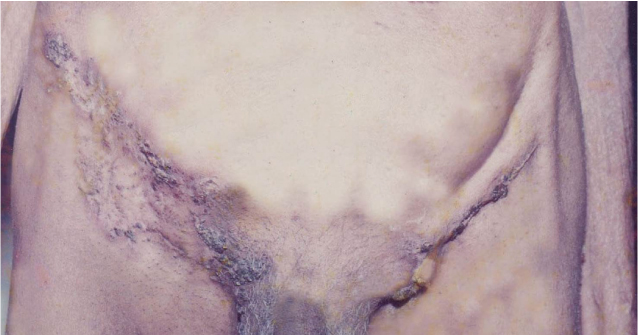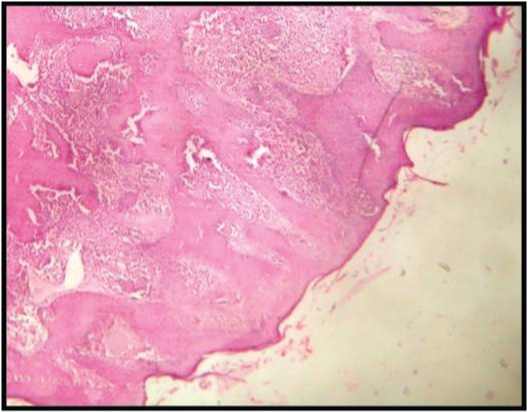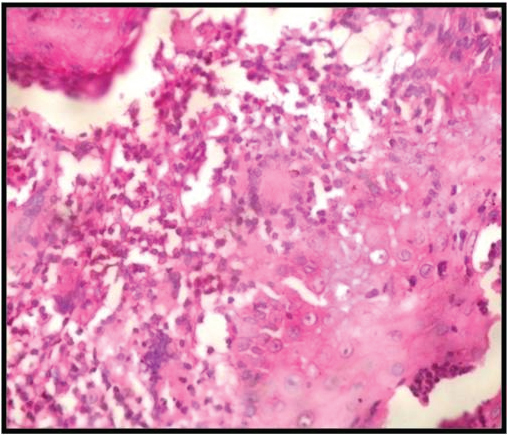Lupus Vulgaris Involving Both Inguinal Regions: A Case of Autoinoculation
Rita Vipul Vora1, Nilofar Gulamsha Diwan2, Nidhi Bhimjibhai Jivani3, Rochit Rajesh Singhal4
1 Head of Department and Professor, Department of Skin and VD, Shree Krishna Hospital, Karamsad, Anand, Gujarat, India.
2 Resident, Department of Skin and VD, Shree Krishna Hospital, Karamsad, Anand, Gujarat, India.
3 Resident, Department of Skin and VD, Shree Krishna Hospital, Karamsad, Anand, Gujarat, India.
4 Resident, Department of Skin and VD, Shree Krishna Hospital, Karamsad, Anand, Gujarat, India.
NAME, ADDRESS, E-MAIL ID OF THE CORRESPONDING AUTHOR: Dr. Rita Vipul Vora, Skin OPD-111, Shree Krishna Hospital, Karamsad, Anand-388325, Gujarat, India.
E-mail: ritavv@charutarhealth.org
Giant cells, Granulomas, Montoux test, Tuberculosis
A 70-year-old male, farmer developed reddish brown verrucous lesion over left inguinal region since 7 years and almost similar lesion was present over right inguinal region since 4 years. No systemic symptoms like cough, fever, weight loss or dyspnoea were present. There was no past or family history of tuberculosis. On cutaneous examination, there was a brownish plaque involving whole right inguinal region with central area of atrophy and hyperkeratotic border at periphery, whereas lesion over other side was hyperkeratotic and involving medial two third of left inguinal region [Table/Fig-1]. Left inguinal group of lymph nodes were enlarged and palpable. Other lymph nodes were normal.
Brownish plaque involving whole right inguinal region with central area of atrophy and hyperkeratotic border at periphery and hyperkeratotic over medial two third of left inguinal region.

Montoux Test was positive. X-Ray chest was normal. ESR was high (65mm/hr) and lymhocytosis was present. Routine haematological and biochemical investigations were normal. HIV by ELISA Method was negative. Histopathological examination was suggesting lupus vulgaris showing tuberculoid granuloma composed of epitheloid cells, Langhans type of giant cells and lymphocytic infiltration in upper dermis. With atrophy of epidermis [Table/Fig-2,3]. Patient was given antituberculous treatment but was lost on follow-up.
Atrophy of epidermis (H&E 100 X).

Tuberculoid granuloma composed of epitheloid cells, Langhans type of giant cells and lymphocytic infiltration in upper dermis (H&E 400 X).

Tuberculosis (TB) is a very common disease worldwide, especially in developing countries. Cutaneous TB can be classified into inoculation TB, secondary TB, haematogenous TB and eruptive TB. More recently, it has been suggested that a useful concept is the mycobacterial load and that TB can be classified into multibacillary forms where there are abundant mycobacteria (e.g.. scrofuloderma, tuberculous chancre and acute miliary tuberculosis) and paucibacillary forms where mycobacteria are difficult to isolate (e.g., lupus vulgaris, TB verrucosa cutis) [1]. Pyogenic infection of the gluteal region is also common in India and the breach in the integrity of the skin can serve as a portal of entry for the Acid-fast bacilli (AFB).
Lupus vulgaris and scrofuloderma are the oldest forms of cutaneous TB described in the medical literature and were known as the king’s evil [2]. The word ‘Lupus’, meaning wolf, was given to the lesion because of the ulcerating and devouring character of the lesion [3]. Lupus vulgaris is a form of reinfection TB of the skin occurring in patients with moderate to high degree of immunity, originating from an underlying TB focus of the skin. However, it may also result through exogenous inoculation. Lupus vulgaris at the site of BCG vaccination has also been reported [1]. Lupus vulgaris is the most common form of cutaneous TB in most of the studies from India. It occurs in individuals with immunity produced by previous tuberculous. Infection most commonly affects the trunk and lower extremities while face is most common site of involvement among Western population.
It initially presents as a tiny, red-brown coloured papulonodular lesion later on forming a plaque with peripheral enlargement of the existing lesion. Healing and scarring in one area and active disease in another area is seen characteristically. Histopathology shows tuberculoid granulomas composed of lymphocytes, plasma cells, epitheloid cells and giant cells, scant or absent central caseation, in the superficial dermis. The epidermis is usually hyperplastic, but may be atrophic or ulcerated. Tubercle bacilli are difficult to demonstrate. Histologic examination is mandatory and in some cases sparse AFB can be demonstrated. Tuberculin test is helpful as it is strongly positive. Special test like Polymerase Chain Reaction (PCR) for TB can be done to substantiate the diagnosis or wherever the histopathology is inconclusive [1].
Wound infection due to M. tuberculosis is not so commonly seen [4]; Presentation of lupus vulgaris as a mirror image over inguinal region is also unique. The presentation is suggestive of autoinoculation and also the potential of infectivity to the other areas of the body [5]. With the differential in mind by the physician, avoidance of ignorance among patients regarding disease and adherence to proper anti-tuberculous treatment can help in cure of the condition. Here, we present a case of lupus vulgaris with bilateral inguinal involvement which suggests autoinoculation.
[1]. Yates V.M, Mycobacterial infectionsIn Rook’s Textbook of Dermatology 2010 318th edWiley-Blackwell:10-29.Tony B, Stephen B, Neil C, Christopher G [Google Scholar]
[2]. Sierra X, Historia de la tuberculosis cutáneaPiel 1995 10:118-26. [Google Scholar]
[3]. Findlay GH, Bacterial infectionsIn: The dermatology of Bacterial infections 1987 1st edLondonBlackwell Scientific:71-83.Ed. Findlay GH [Google Scholar]
[4]. Dalton HP, Archer OL, Slifiein M, Harris RC, Stone LL, Sosnowski KM, Wound and Skin Specimen. In: Dalton HP, Nottebart HC. editorsInterpretive Medical Microbiology 1986 New YorkChurchill Livingstone:698 [Google Scholar]
[5]. Sehgal VN, Chaudhry AK, Gupta R, Autoinoculation lupus vulgaris of the perineumGenitourin Med 1991 67:348-49. [Google Scholar]